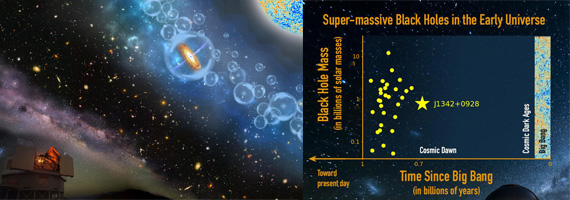
The Most Distant Quasar in the Universe Discovered: A Massive Black Hole at Cosmic Dawn
An international team of astronomers led by Dr. Eduardo Bañados at Carnegie Observatory, including UA Professor Xiaohui Fan and postdoctoral fellow Jinyi Yang, announced in Nature the discovery of the most distant quasar yet known. This object is at a redshift of 7.54, or a distance of more than 13 billion light years. The quasar is powered by a supermassive black hole 800 million times more massive than the Sun. Remarkably, this black hole was fully formed when the Universe was only 700 million years old, or 5% of its current age. Detailed observations of this quasar further reveal that the quasar resides in a primarily neutral and cold Universe. Soon afterwards, radiation from the earliest generations of galaxies reheated the intergalactic gas ('reionization') in the Universe which had cooled down after the Big Bang.
This record-breaking quasar was discovered using the 6.5m Magellan-1 Baade Telescope at Las Campanas Observatory in Chile. Further observations were obtained with the 2x8.4m Large Binocular Telescope on Mt. Graham in Arizona and the 8.2m Gemini North Telescope in Hawaii. UA is a partner of both the Magellan and the LBT consortia.
The left part of the photo shows a timeline of the Universe, with today in the lower left and a few hundred thousand years after the Big Bang in upper right. In between the early Universe and the formation of galaxies is the "Dark Ages". When quasars and galaxies began to shine, they created bubbles of ionized gas around them until the entire Universe was ionized. This particular quasar probes the time when the Universe was NOT completely ionized. The figure on the right shows the distribution of known supermassive black holes in the early Universe as a function of time since the Universe began, showing that this quasar probes an earlier time than the rest. While this new quasar does not have the most massive supermassive black hole in its center, it formed very early in the Universe, before simple models can explain such formation.
The UA News article is HERE. Here is a link to NOAO press release. Here is a link to the Nature paper preprint. The Arizona Daily Star article is HERE. The Sky and Telescope article is HERE.

For Public
Public events include our Monday Night Lecture Series, world-reknowned Astronomy Camp and Mt Lemmon Sky Center.

For Students
A good place to start if you want to become an undergrad major or grad student, or need to find our schedule of classes.

For Scientists
Find telescopes and instruments, telescope time applications, staff and mountain contacts, and faculty and staff scientific interests.




